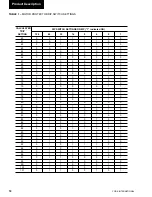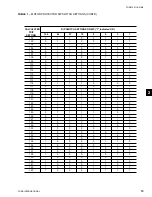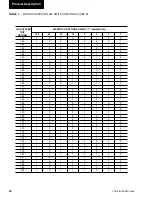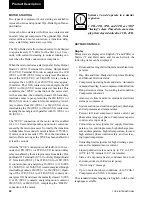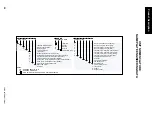
14
YORK INTERNATIONAL
gered rows and mechanically expanded into corrosion
resistant aluminum alloy fins with full height fin col-
lars. They have a design working pressure of 31 bar
(450 PSIG). Each coil is rested to 34 bar (495 PSIG).
Multiple fans move air through the coils. They are dy-
namically and statically balanced, direct drive with cor-
rosion resistant glass fiber reinforced composite blades
molded into low noise, full airfoil cross section, pro-
viding vertical air discharge from extended orifices for
efficiency and low sound. Each fan is located in a sepa-
rate compartment to prevent cross flow during fan cy-
cling. Guards of heavy gauge, PVC coated galvanized
steel are provided.
The fan motors are high efficiency, direct drive, 6-pole,
3-phase, Class- “F,” current overload protected, totally
enclosed (TEAO) type with double sealed, permanently
lubricated ball bearings.
Economizer
(Models YCAS 270, 330 and 440)
A plate and frame heat exchanger (economizer) is fit-
ted to both refrigerant circuits on models YCAS 270,
330 and 440. This increases the efficiency of the sys-
tem by subcooling the primary refrigerant liquid to
the evaporator.
The wet vapor to the economizer is supplied by a small
15 ton TXV set for 5.5°C (10°F) superheat that flashes
off 10 - 20% of the liquid from the condenser. 10 - 12
tons are utilized for subcooling liquid refrigerant. The
wet vapor is at an intermediate pressure between dis-
charge and suction (1.7 x suction) and therefore little
energy is required to pump it back through the com-
pressor to condenser pressure. This results in a very
small loss to system efficiency.
The economizer provides approximately 14°C (25°F)
of additional subcooling to the liquid refrigerant which
flows to the evaporator at 35°C (95°F) ambient, 13°C
(55°F) RWT, 7°C (44°F) LWT. Subcooling will drop to
approximately 0°F below 32°C (90°F) ambient. The
subcooled liquid is then fed to the primary TXV in the
system. This additional subcooling results in a signifi-
cant increase in the efficiency of the system. The de-
sign working pressure of the economizer is 31 bar (450
PSIG). The economizer liquid supply solenoid is acti-
vated on start-up coincident with the liquid line sole-
noid, after pumpdown.
The economizer operation is controlled by the econo-
mizer solenoid valve. This valve is controlled by the
microprocessor. The valve will remain off for the first
3 minutes of compressor operation. After 3 minutes of
operation, the economizer solenoid valve will open if
the slide valve position is > Step 47, and the pressure
ratio (PR) of discharge pressure to suction pressure is
greater than 2.2 using the following formula:
English:
PR
=
DP (PSIG) + 14.7
SP (PSIG) + 14.7
Metric:
PR
=
DP (BAR) + 1
SP (BAR) + 1
The economizer valve will be turned off if the pressure
ratio drops below 2.0. It will also turn off if slide valve
position drops below Step 44. Under these conditions,
the valve is closed due to the lack of efficiency im-
provement available from the economizer.
Oil Separator/System
The external oil separator, with no moving parts and
designed for minimum oil carry-over, is mounted in the
discharge line of the compressor. The high pressure dis-
charge gas is forced around a 90 degree bend. Oil is
forced to the outside of the separator through centrifu-
gal action and captured on wire mesh where it drains to
the bottom of the oil separator and into the compressor.
The oil (YORK “L” oil – a POE oil used for all refrig-
erant applications), which drains back into the com-
pressor through a replaceable 0.5 - 3.0 micron oil filter,
and oil supply solenoid, is at high pressure. This high
pressure “oil injection” forces the oil into the compres-
sor where it is gravity fed to the gears and bearings for
lubrication. After lubricating the gears and bearings, it
is injected through orifices on a closed thread near the
suction end of the rotors. The oil is automatically in-
jected because of the pressure difference between the
discharge pressure and the reduced pressure at the suc-
tion end of the rotors. This lubricates the rotors as well
as provides an oil seal against leakage around the ro-
tors to assure refrigerant compression (volumetric effi-
ciency). The oil also provides cooling by transferring
much of the heat of compression from the gas to the oil
keeping discharge temperatures down and reducing the
chance for oil breakdown. Oil injected into the rotor
cage flows into the rotors at a point about 1.2x suction.
This assures that a required minimum differential of at
least 2.1 bar (30 PSID) exists between discharge and
1.2x suction, to force oil into rotor case, a minimum of
0.6 bar (10 PSID) is all that is required to assure pro-
Product Description
Содержание Millennium YCAS Series
Страница 36: ...36 YORK INTERNATIONAL FIG 8 POWER PANEL SECTION CONT D OPTIONS PANEL LAYOUT TYPICAL 00246VIP Installation ...
Страница 49: ...49 YORK INTERNATIONAL FORM 201 18 NM4 7 This page intentionally left blank ...
Страница 65: ...65 YORK INTERNATIONAL FORM 201 18 NM4 LD04179 7 ...
Страница 79: ...79 YORK INTERNATIONAL FORM 201 18 NM4 This page intentionally left blank 7 ...
Страница 83: ...83 YORK INTERNATIONAL FORM 201 18 NM4 This page intentionally left blank 7 ...
Страница 87: ...87 YORK INTERNATIONAL FORM 201 18 NM4 LD04268 7 ...
Страница 119: ...119 YORK INTERNATIONAL FORM 201 18 NM4 COMPRESSOR COMPONENTS CONT D FIG 57 COMPRESSOR COMPONENTS LD03669 7 ...
Страница 120: ...120 YORK INTERNATIONAL COMPRESSOR COMPONENTS CONT D FIG 58 COMPRESSOR COMPONENTS LD03670 Technical Data ...
Страница 121: ...121 YORK INTERNATIONAL FORM 201 18 NM4 COMPRESSOR COMPONENTS CONT D FIG 59 COMPRESSOR COMPONENTS LD03671 7 ...


















